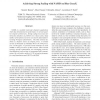CF
2007
ACM
14 years 7 months ago
2007
ACM
In the life sciences, genomic databases for sequence search have been growing exponentially in size. As a result, faster sequencesearch algorithms to search these databases contin...
EUROPAR
2003
Springer
14 years 8 months ago
2003
Springer
Abstract. The Blue Gene/L supercomputer will use system-on-a-chip integration and a highly scalable cellular architecture. With 65,536 compute nodes, Blue Gene/L represents a new l...
EUROPAR
2005
Springer
14 years 9 months ago
2005
Springer
Abstract. Blue Gene/L uses a large number of low power processors, together with multiple integrated interconnection networks, to build a supercomputer with low cost, space and pow...
SPAA
2006
ACM
14 years 9 months ago
2006
ACM
LOFAR is the first of a new generation of radio telescopes, that combines the signals from many thousands of simple, fixed antennas, rather than from expensive dishes. Its revol...
PPOPP
2006
ACM
14 years 9 months ago
2006
ACM
Large-scale simulations and computational modeling using molecular dynamics (MD) continues to make significant impacts in the field of biology. It is well known that simulations...
IPPS
2006
IEEE
14 years 9 months ago
2006
IEEE
The Replica Exchange method is a popular approach for studying the folding thermodynamics of small to modest size proteins in explicit solvent, since it is easily parallelized. Ho...
IPPS
2006
IEEE
14 years 9 months ago
2006
IEEE
NAMD is a scalable molecular dynamics application, which has demonstrated its performance on several parallel computer architectures. Strong scaling is necessary for molecular dyn...
IPPS
2007
IEEE
14 years 9 months ago
2007
IEEE
— Frequent failure occurrences are becoming a serious concern to the community of high-end computing, especially when the applications and the underlying systems rapidly grow in ...



